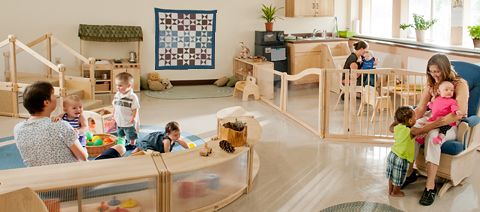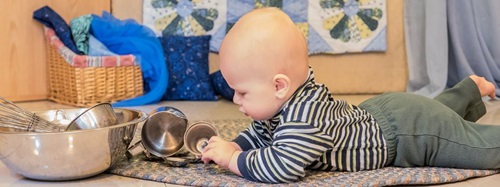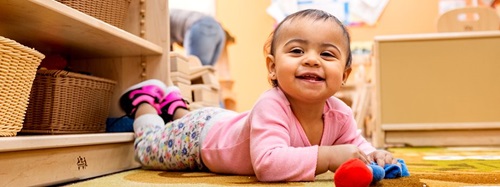Quality Environments for Infants
| January 2010Imagine a room with light streaming in the windows, shadows dancing on the floors and walls, and a richly textured world of different shapes and sizes of furniture to climb on, over, around, and in—with places to just sit, places to snuggle. It is a room where you can sometimes make wild messes as you discover the mysteries of sensuous substances that often end up on you. It is a room with different places to be, just like your house—places that look, feel, sound, and smell different. There are lilacs here and baskets of ivy hanging by the window. There is a door to the outside, that wonderful place with grass and sun and shade. Out there the messes can be even wilder and you are free to kick up your heels—sorry, you can’t do that—let’s say instead bounce and waddle with abandon, roll and swing, twist and shout.
It is not a room dominated by cribs, nor are you sandwiched between the glare of florescent lights and gleaming tile. It is not a tiny cell-like space where the day is divided into time on the crowded rug, the bounce chair, and the crib—nor is it a room filled with tables and chairs and a random assortment of toys, where activities are put out to keep the group busy.
In the room are large and small people interacting; the interactions are warm and relaxed and frequent. There are real conversations between adults and children. Adults listen to children and respond to their vocalizations.
Look closely and see—it is a room filled with individuals. There is Stephen, striding into the room like Louis the Sun King, expecting to be loved, his good nature surrounding him like a bumper. There is Alexander, always a worried man who likes to be held. And Alicia, who likes to sample everything, and JoAnna, who needs a morning nap.
Children are trying to “do it myself”—infants holding spoons and cups, toddlers pouring milk and wrestling with zippers.
Parents clearly belong in the room; one feels their presence through photographs and the information directed toward their eyes. The warmth with which they are welcomed and their familiarity with the life occurring within leaves little doubt that it is their place as well.
There is a sense of security: both the security that comes from knowing that this is a safe place for children, beyond the normal bumps and bruises that go with active learning, and the child’s security that she is truly known, understood, and accepted for who she is.
There is a sense of engagement: when adults interact with children they give them their full human presence. When children are exploring the world and their emerging powers, they are intent.
There is a sense of active learning: children are genuinely INTO things, and ALL OVER things, as befits creatures that learn with all of their senses and through whole body action.
Unfortunately, it is not easy to find programs with these characteristics. Probably fewer than one in ten centers are truly good places for babies. Quality does not come easily or inexpensively.
Quality care for babies is not brandishing an infant curriculum or infant stimulation. It is not spic and span tile and formica, or attractive lofts, or a bump-free environment, or even low ratios and smiley, warm people. Quality is each and every child experiencing warm, personal care and developmentally appropriate opportunities for sensory, motor, and language learning. Quality is parents feeling in control.
How Does Quality Happen?
Without infant ratios of no worse than one adult to four children, toddler ratios of one adult to five children, it will not happen, or at least happen for all of the children all of the time. And quality depends on people who genuinely appreciate babies for who they are, for what they can do right now, not just what they will be able to do or are in the process of becoming. But good ratios and good people don’t guarantee quality.
Quality happens because the environment—time and space—is designed and planned to support care and learning. The setting is furnished, equipped, and organized to maximize the caregiver’s time. Quality is a result of considerable thought and planning: maximizing resources, adjusting to individual needs and changing circumstances.
The Importance of Built-In Learning
An essential quality of good infant and toddler programs is moving away from a traditional early childhood focus on activities and building learning into the environment. When learning is built in, it frees caregivers to be with children and focus on the child: to take the time to slowly diaper a child, or to help a child through the agony of separation, or to appreciate the joy of new-found discoveries. These are the prime times, the important times. It is upside-down priorities to rush through these times to get back to teaching or managing children.
While teacher-directed activities may take place, there are always other opportunities for those toddling to a different drummer. Activities take place individually and with small groups within an environment rich with opportunities for vigorous motor and sensory exploration.
The Importance of an Organized, Convenient Environment for Staff
Convenience and organization buy time for staff to spend precious minutes with a child. Poor storage and inadequate equipment result in lower quality.
What Kind of Place for Babies?
A Safe and Healthy Place
Good places for babies follow the National Health and Safety Performance Standards: Guidelines for Out-of-Home Child Care Programs in Caring for Our Children, developed by the American Public Health Association and the American Academy of Pediatrics standards for group care.
But there are also two important understandings:
- Learning involves the risk of acquiring the normal bumps and bruises of childhood, the natural result of learning to explore the world with a developing body.
- Sanitary and clean are not the same thing and are usually confused. A good program has a vigilant concern for avoiding the spread of germs and disease, but not a preoccupation with cleanliness that gets in the way of sensory exploration and other active learning.
A Good Place to “Be”
A good place to be a baby and be with a baby for long days and weeks includes:
- sufficient room for adults (including a few parents) and children
- windows and doors to the outside
- home-like lighting that allows a variety of lighting conditions
- multiple places to be that feel different when you are there
- places to pause that allow you to step back from the action
- soft places and more soft places: pillows, couches, futons
- enough tile surface for eating and the rest, carpet
- a separate crib room or area that accommodates individual schedules
- plants and multi-textured decor
- an outdoors area of shade and sun, grass and deck, hills and flats, things to climb on, and loose parts to collect
A Good Place to Learn
Nearly all the important learning in the first two years of life is sensory, motor, language, and self-knowledge: “I am important, competent, powerful, and connected to others.” A good place to learn is filled with challenge and exploration:
- large motor learning: climbing, pushing, grabbing, and motor opportunities of all kinds
- sensory learning: a world at their fingertips to touch, taste, smell, see, and hear
- language: conversations, listening to children, reading
- expression and accomplishment: opportunities to express yourself in motion and mess (art), solve problems, and do-it-yourself
- loose parts to inspect, collect, dump, and sort
A Good Place to Work
A good place to work needs:
- water and toilets, where they are needed
- ample storage, close to the point of use
- ample information space, close to the point of use
- clear organization and signage
- cleaning supplies, right there
A Good Place for Parents to Be
Parents are welcome, greeted, and helped to understand how the room works. There is storage space for their things.
A Final Note: Babies in the Real World
Babies deserve more than they usually get from group care. Too many programs are too hard, inflexible, over- or under-stimulating, and tolerate too much child distress. But it is not really the people involved who are to blame. Many programs for babies are the equivalent of shanty towns, makeshift creations put together out of the wonderful stuff we can find and keep, the found and purchased spaces and materials barely adequate for the task, and all the energy and love and commitment that can be mustered. It is easy to accept what is and avoid criticism of programs doing the best they can. But at what cost to children? It is our job to assert what quality is and to push for the resources for all programs to achieve it.






